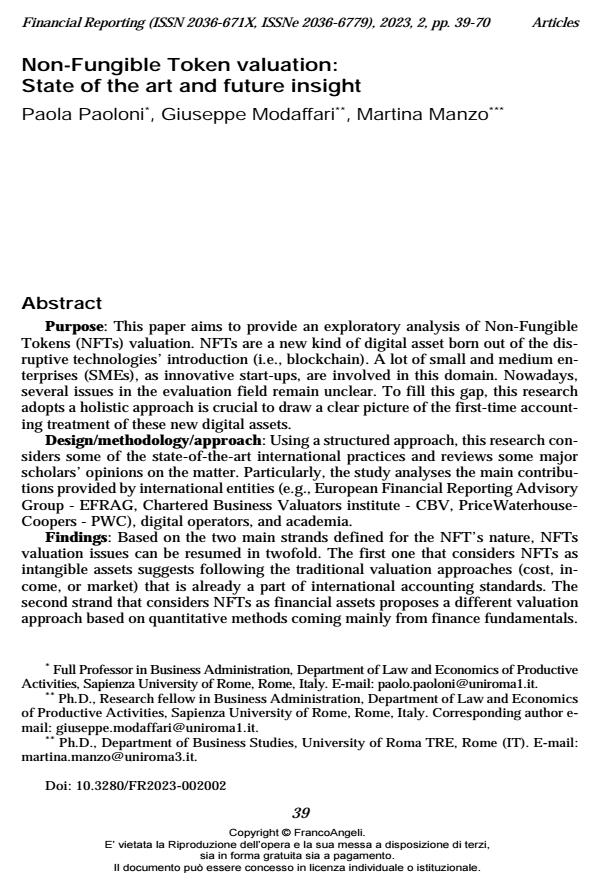Non-Fungible Token valuation: State of the art and future insight
Titolo Rivista FINANCIAL REPORTING
Autori/Curatori Paola Paoloni, Giuseppe Modaffari, Martina Manzo
Anno di pubblicazione 2023 Fascicolo 2023/2
Lingua Inglese Numero pagine 32 P. 39-70 Dimensione file 209 KB
DOI 10.3280/FR2023-002002
Il DOI è il codice a barre della proprietà intellettuale: per saperne di più
clicca qui
Qui sotto puoi vedere in anteprima la prima pagina di questo articolo.
Se questo articolo ti interessa, lo puoi acquistare (e scaricare in formato pdf) seguendo le facili indicazioni per acquistare il download credit. Acquista Download Credits per scaricare questo Articolo in formato PDF

FrancoAngeli è membro della Publishers International Linking Association, Inc (PILA)associazione indipendente e non profit per facilitare (attraverso i servizi tecnologici implementati da CrossRef.org) l’accesso degli studiosi ai contenuti digitali nelle pubblicazioni professionali e scientifiche
Purpose: This paper aims to provide an exploratory analysis of Non-Fungible Tokens (NFTs) valuation. NFTs are a new kind of digital asset born out of the dis-ruptive technologies’ introduction (i.e., blockchain). A lot of small and medium en-terprises (SMEs), as innovative start-ups, are involved in this domain. Nowadays, several issues in the evaluation field remain unclear. To fill this gap, this research adopts a holistic approach is crucial to draw a clear picture of the first-time ac-counting treatment of these new digital assets. Design/methodology/approach: Using a structured approach, this research considers some of the state-of-the-art international practices and reviews some major scholars’ opinions on the matter. Particularly, the study analyses the main contributions provided by international entities (e.g., European Financial Reporting Advisory Group - EFRAG, Chartered Business Valuators institute - CBV, PriceWa-terhouseCoopers - PWC), digital operators, and academia. Findings: Based on the two main strands defined for the NFT’s nature, NFTs valuation issues can be resumed in twofold. The first one that considers NFTs as intangible assets suggests following the traditional valuation approaches (cost, in-come, or market) that is already a part of international accounting standards. The second strand that considers NFTs as financial assets proposes a different valua-tion approach based on quantitative methods coming mainly from finance fun-damentals. Originality/value: The originality of this study includes the different NFT val-uation approaches, which enrich the literature and can help SMEs in managing and accounting for this new kind of digital asset.
Parole chiave:Non-fungible token; valuation; Accounting; Disclosure.
Jel codes:M100
Paola Paoloni, Giuseppe Modaffari, Martina Manzo, Non-Fungible Token valuation: State of the art and future insight in "FINANCIAL REPORTING" 2/2023, pp 39-70, DOI: 10.3280/FR2023-002002